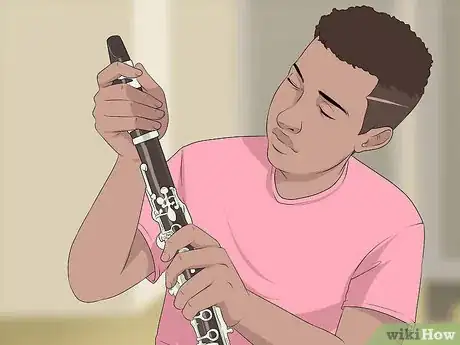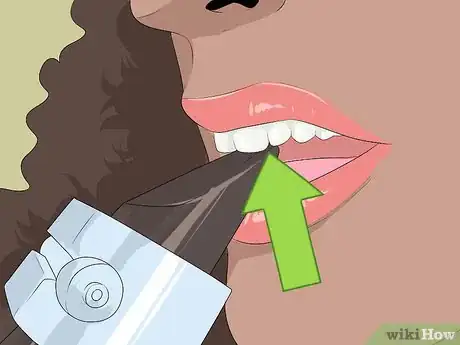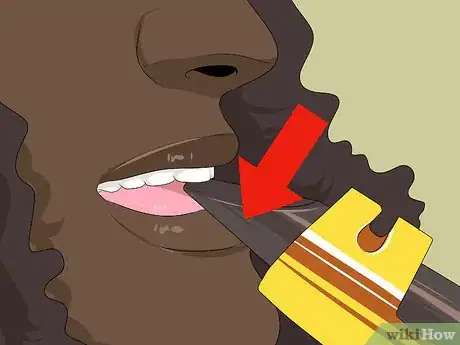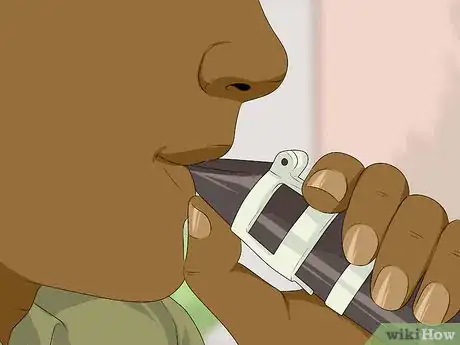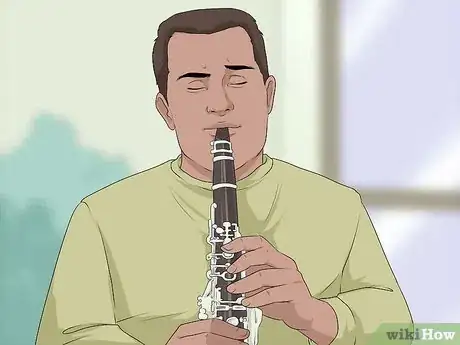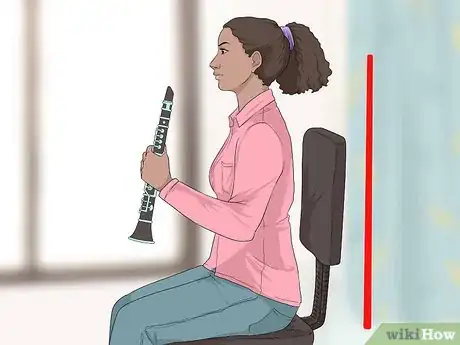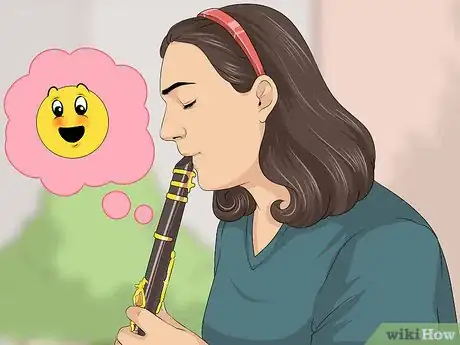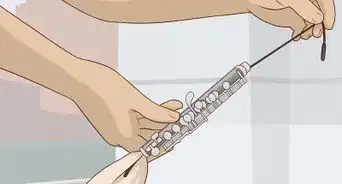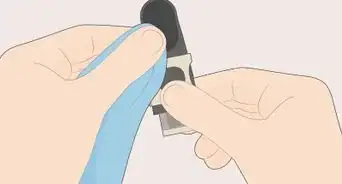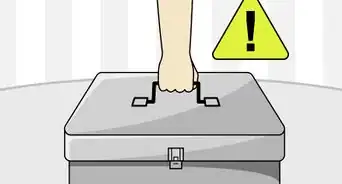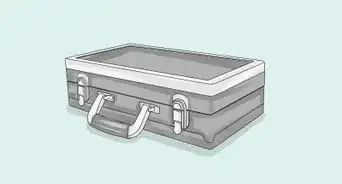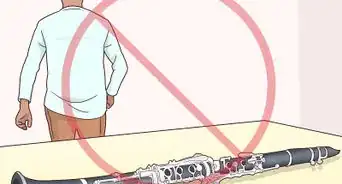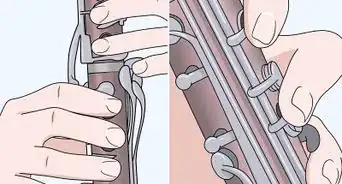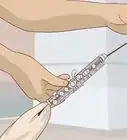X
wikiHow is a “wiki,” similar to Wikipedia, which means that many of our articles are co-written by multiple authors. To create this article, 19 people, some anonymous, worked to edit and improve it over time.
This article has been viewed 68,581 times.
Learn more...
If you're a first time clarinet player, or if you keep making embarrassing squeaks, read this. This is a guide for playing for the first time, or doing a mouthpiece warm-up. Developing a correct embouchure is very important, as a bad embouchure will affect your playing, and even more so as you continue your music education.
Steps
-
1Assemble your clarinet and make sure your reed and ligature are positioned correctly. Your clarinet should be between 4 and 6 inches above you.[1]
-
2Place your two top front teeth onto the flat surface opposite of the reed, about 1 centimeter (0.4 in) to 1.5 centimeters (0.6 in) from the tip. Experiment with this as you get to playing, if this placement doesn't work for you.[2]Advertisement
-
3Place your bottom lip so it goes over your bottom teeth - don't put too much of your lip into your mouth - and put your lip onto your reed. Try to stretch your lower lip out as if you are putting on lipstick, which will flatten your chin and help you to produce a better tone.[3]
-
4Wrap your lips around the mouthpiece in a "closing the drawstring" fashion to make sure the air is locked, but don't squeeze the reed too hard, or you'll squeak.[4]
-
5Position the mouthpiece so it points down. If you point it forward, it won't create as great of a sound.[5]
-
6Sit up straight, and don't let your back slouch and touch the chair. Scoot forward slightly in your seat. This helps improve air flow and tone quality. This is very important because slouching will diminish the quality of your sound.[6]
-
7Close your eyes, think happy thoughts, and blow into the instrument. Start softly, so you can barely hear it, then start increasing the volume by blowing more air in the clarinet. If you've done it right, it should make a nice sound instead of a squeak or a weak noise. If not, try adjusting how much mouthpiece is in your mouth.
Advertisement
Community Q&A
-
QuestionAll I get is air when I blow, no sound at all. What do I do?
 Community AnswerCreate a flat chin. To do this, pull the bottom lip across your teeth and cover the top of these teeth with a thin row of lip. It is here that you rest the reed. Next, position the mouthpiece to be even with where the reed and mouthpiece join on the lower lip. Close your upper lip and corners around the mouthpiece, finally, and blow. Also, consider the reed position to the mouthpiece, the reed strength, brand, and if it is soaked, that the ligature fastens the reed securely to the mouthpiece, and you're not biting the reed closed. Make sure you use more air than you think you should!
Community AnswerCreate a flat chin. To do this, pull the bottom lip across your teeth and cover the top of these teeth with a thin row of lip. It is here that you rest the reed. Next, position the mouthpiece to be even with where the reed and mouthpiece join on the lower lip. Close your upper lip and corners around the mouthpiece, finally, and blow. Also, consider the reed position to the mouthpiece, the reed strength, brand, and if it is soaked, that the ligature fastens the reed securely to the mouthpiece, and you're not biting the reed closed. Make sure you use more air than you think you should! -
QuestionI cant play the high notes because it either squeaks or doesn't make a sound at all. I don't know if its the reeds or something else. Please help.
 Community AnswerTighten your embouchure, and give these notes plenty of air support. Breathe deeply, and make sure your fingerings are correct as well.
Community AnswerTighten your embouchure, and give these notes plenty of air support. Breathe deeply, and make sure your fingerings are correct as well. -
QuestionHow do I play high notes?
 Community AnswerYou use the "register key" in front of the clarinet which is shaped like a bowling pin and the front hole simultaneously paired by some other fingers.
Community AnswerYou use the "register key" in front of the clarinet which is shaped like a bowling pin and the front hole simultaneously paired by some other fingers.
Advertisement
Warnings
- Don't puff your cheeks when you play. It makes for a bad sound, and it's a really bad habit to get into.⧼thumbs_response⧽
- Since you're resting your top teeth on the mouthpiece, over time, this can loosen your top teeth slightly, and can even make long sessions of playing painful. You can solve this problem by buying a mouthpiece cushion, which is a little piece of rubber that goes where your front teeth sit to give them a more comfortable place to sit.⧼thumbs_response⧽
- If you push the clarinet too heavily into your bottom lip and play for a long period of time, you may end up with teeth marks on the inside of your bottom lip, which isn't comfortable.⧼thumbs_response⧽
- Your upper teeth should grip the mouthpiece firmly so that the clarinet stays in place, but don't bite down any harder than you have to. Extra tension will cause the sound to waver, make it harder to keep the air flowing smoothly, and generally make it harder to play.⧼thumbs_response⧽
- Remember that the embouchure exists to provide a supportive and consistent pathway between your body and the clarinet. It should not change dramatically when you go over a break into a different register or when you play a difficult passage.⧼thumbs_response⧽
Advertisement
Things You'll Need
- Clarinet
- Good sized reed (2 or 2.5 for beginners)
- (Optional) Mouthpiece cushion
References
- ↑ http://www.clarinetcloset.com/clarinetassembly.html
- ↑ https://owd.tcnj.edu/~mckinney/clarinet_embouchure.htm
- ↑ https://www.youtube.com/watch?v=9WcvrTqE-yk
- ↑ https://youtu.be/L9ishHBJpbE?t=78
- ↑ http://www.the-clarinets.net/english/clarinet-how-to-play.html
- ↑ http://web.uniarts.fi/harjoittelu/index671c.html?id=181&la=en
About This Article
Advertisement
